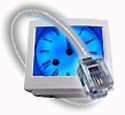|
 Waiting for pages to load on the Web can
be like trying to suck a thick milkshake through a small straw葉itillating,
but not very satisfying. Just as
prying the lid off and gulping the milkshake down is much more enjoyable, broadband
Internet service can spell the end of excruciating load times and the beginning
of a whole new Internet experience. Waiting for pages to load on the Web can
be like trying to suck a thick milkshake through a small straw葉itillating,
but not very satisfying. Just as
prying the lid off and gulping the milkshake down is much more enjoyable, broadband
Internet service can spell the end of excruciating load times and the beginning
of a whole new Internet experience.
Broadband means speed
Broadband Internet
service can be from 25 to 100 times faster than a standard 56-kbps
modem, with a continuous, uninterrupted connection to the
Internet--for not much more than the cost of a standard dial-up
connection. And many of the exciting and highly-touted new
technologies of the Web, like real-time video phone calls,
interactive Internet gaming, video-on-demand, and streaming music
and video; not to mention everyday tasks--like looking up
telephone numbers or downloading files--are much quicker and
better with broadband Internet access.
Currently, the two leading broadband technologies are
Digital Subscriber Line (DSL) service, a technology that works over
standard telephone lines, and cable broadband, which uses the
same wire that brings cable television to your home. As availability
of these technologies becomes more and more widespread, the question
may not be whether or not to sign up, but which one to use.
Connect
with cable
Cable companies currently boast
Web access at speeds of up to 100 times faster than standard
dial-up connections, and hooking up cable Internet access is as easy
as installing cable television in your home. There is typically
a one-time set-up fee, and monthly rates average around US$40
per month, including all the necessary equipment.
If your local cable television company offers Internet access,
they will send a technician to install a device called a splitter
that separates an Internet line from the television cable into your
home. The new line plugs into a cable modem--usually provided by the
cable company--which then connects to an Ethernet network card
(sometimes called a Network Interface Card, or NIC) in your
computer. Just like that, you are up and running.
With its low cost and easy installation, cable is currently the
most-popular broadband option. There is, however, a drawback. Cable
Internet service is affected by how many users are online, so as
more people in your neighborhood sign up for service and begin to
use it, your performance may be affected. Thus, some providers now
employ limitations on service, such as how long you can listen to a
streaming media broadcast, or how much data you can transmit.
Hook up with the phone
company
Digital
Subscriber Line (DSL) service works on the telephone
line that's already
in your house. Data is transmitted digitally on a
different frequency than voice signals, so you can talk on
the phone or receive calls, even when you're online. DSL service
is either provided by the phone company or, in many cases, by an
arrangement with a local Internet service provider (ISP).
As with cable broadband, you値l need a special modem that connects to a network card in
your computer. Some types of DSL require a visit from the
telephone company to install a splitter to separate the Internet hook-up from
the voice signal, and sometimes a separate visit to install the
modem and the network card. Since DSL modems can be quite expensive,
and the installation somewhat complicated, many DSL providers now include
free or discounted hardware and installation as an incentive to sign up.
Once you are online with DSL, data transmission rates will remain
the same, regardless of how many users sign up for the
service or go online at any given time.
Which one to
choose?
Though cable and telephone companies
and Internet service providers are all working hard to increase
availability of broadband service, DSL or cable broadband access may
not yet be offered where you live. Contact your cable company, your
local telephone company, your current ISP, or use the resources to
the right of your screen to find out what service is available in
your area.
You値l be using an ISP with either option, so compare features
like monthly rates, sign-up incentives and fees, and service
limitations between cable and DSL, and between providers.
Whichever service you choose, you値l have much quicker Web
access for only slightly more than a separate phone line with a dial-up
connection would cost. Long waits and annoying time-outs will
be a thing of the past, you値l
find the Internet much more useful and easy to
use, and you'll be ready for the next generation of Web technologies.


Mark Reed hopes to
never go back to a
dial-up connection
again. |
Looking for broadband
content? The WindowsMedia.com Broadband
Guide is a comprehensive guide
to broadband Windows Media content on the Web. You値l find the best in
broadband news, sports and entertainment video.
The guide also includes a list of broadband
access providers to help you find a high-speed
connection in your area.
Computing Central maintains a
list of cable modem service providers organized by region.
You'll find links to the Web pages of your cable TV provider, the
ISP that will host your cable modem access, and information on the
type of cable modem you'll be using.
Having problems? See the
Microsoft support article: Troubleshooting
Cable Modems in Windows 98. |
